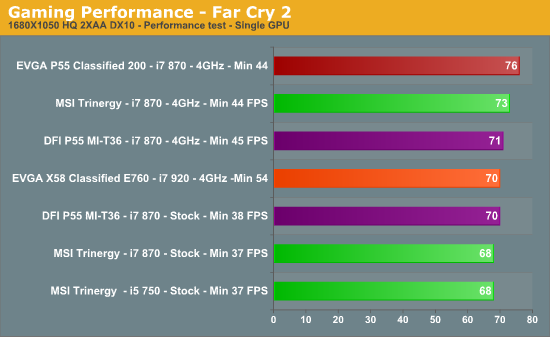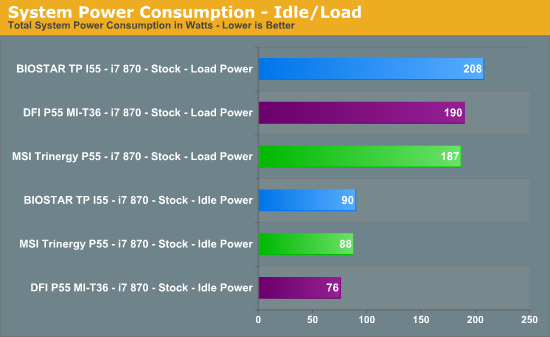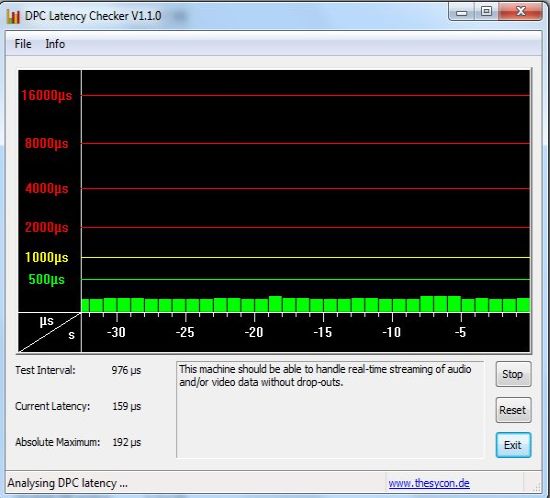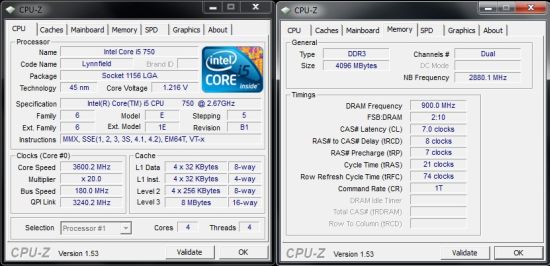Performance Summary
It's the same old story on the performance front; all P55 boards perform about the same during fixed frequency tests.


For the next test we measured AC power consumption from the wall while using the same set of components on all boards. All power saving features were turned on, with OS software installed where necessary to give maximum power saving at stock operating frequency on our i7 870 CPU. Real power consumption will probably be a few percent lower than what the AC wall meter reports but as we're going apples to apples here, the percentage of change is the important factor.

DFI's MI-T36 produces respectable power consumption figures during idle and full load scenarios, bettered only slightly by MSI, who are the class leaders when it comes to power saving features and software.
As part of the performance summary, we also include a DPC latency screenshot for the audio aficionado's out there;

Overclocking
DFI offers plenty of overclocking features within the current BIOS. However, the VRM for processor VCore is limited to 150w max (110w in the near future). Although we managed to pass our gaming tests at 4GHz, 860/870 CPUs are best left near stock operating frequency to avoid catastrophic board failure during heavy load tests.

We overclocked our 750 CPU to 3.6GHz with a 1800MHz memory speed at 7-8-7-20 timings (180BCLK x 20). Voltages were 1.25V CPU VCore, 1.25VTT and 1.65VDIMM. All other voltages were left at stock. On the DRAM side, we only needed to set the primary timings; the board defaults were perfectly adequate for this speed. We must add that we were using an open test bed and pointing a high speed fan directly over the PWM area. Within a PC case, we think you're going to be limited to stock operating frequencies on the CPU. S3 Sleep mode recovery is limited to around 150 BCLK on the current BIOS too, anything higher and the board gets caught in a reboot loop.










38 Comments
View All Comments
yacoub - Monday, January 4, 2010 - link
Is Gary Key still writing for Anandtech? I noticed he hasn't posted in a while and his email address @anandtech bounced the other day, though I've successfully emailed him there before and gotten responses.If he left, where did he go? His motherboard reviews were usually thorough, superb, and very much appreciated.
(Your review is fine, I am just wondering what happened to Gary Key.)
JarredWalton - Monday, January 4, 2010 - link
I can confirm that Gary left us to go work for someone else last month. I'm sure he'll still read the site, but his new job prevents him from writing for us now. We wish him the best, though!yacoub - Monday, January 4, 2010 - link
Ah okay, thanks for the update. I guess he's working for one of the companies who make products you guys review, not another news site? :)JarredWalton - Monday, January 4, 2010 - link
Yeah, I thinks it's okay for us to mention he's at ASUS now.yacoub - Monday, January 4, 2010 - link
Oh very cool! :)vol7ron - Monday, January 4, 2010 - link
I like to see more reviews of mini-ITX. Cases and boards.This is the year of the HTPC.
DigitalFreak - Monday, January 4, 2010 - link
Surprisingly enough, the price isn't bad. $134 @ Newegg.fr500 - Tuesday, April 6, 2010 - link
Hi anandDid you tell DFI about the reboot loop problem, S1 works fine but the GPU fan ramps up to 100% on S1 so it's unusable, and S3 has the aforementioned problem of random waking up and get stuck in a reboot loop.
S3 is VERY important on an HTPC board imho. S4 works too but it's still too slow for day to day usage.
If it can't be fixed guess I'll have to clock down to stock overclocking via software when gaming or get a passive cooled GTS250 instead of the current active cooled one.